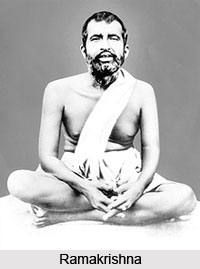 Ramakrishna, a great teacher gained the popular appeal by the way of his simplicity to express the theme of spirituality and oneness of God. According to him, money and sex bar people from achieving the supreme goal of god-realizations. He depicted lust and money as "kama kanchana" or "women and gold" from which he always advised his disciples to abandon. While preaching to his women disciples he focused on "purusha kanchana" or "man and gold". Ramakrishna`s advice to the people was, "He is truly a man to whom money is only a servant; but, on the other hand, those who do not know how to make proper use of it, hardly deserve to be called men."
Ramakrishna, a great teacher gained the popular appeal by the way of his simplicity to express the theme of spirituality and oneness of God. According to him, money and sex bar people from achieving the supreme goal of god-realizations. He depicted lust and money as "kama kanchana" or "women and gold" from which he always advised his disciples to abandon. While preaching to his women disciples he focused on "purusha kanchana" or "man and gold". Ramakrishna`s advice to the people was, "He is truly a man to whom money is only a servant; but, on the other hand, those who do not know how to make proper use of it, hardly deserve to be called men."
According to Ramakrishna, the entire cosmos is the veil of Maya. Avidya Maya which denotes sensual desires, greed, evil passion, cruelty, lust and evil desires is embedded in the human body and obstruct from reaching to the height of higher consciousness of soul. The "Avidya Maya" is hold responsible for human entrapment in the cycle of birth and death. The "Vidya Maya" the connotation of virtues like kindness, love, spiritual virtues, devotion and enlightening qualities is depicted to be the force to aggrandize the human spirit to the higher consciousness.
Being the practitioner of several religions, Ramakrishna perceived that all religion say the same thing and lead to the identical goal of the realization of the supreme-God. Ramkrishna`s mystical realization which in Hindu tradition was termed as Nirvikalpa Samadhi (meaning "constant meditation", considered to be a state of absorption in the all encompassing Consciousness) accompanied him to the ultimate truth that there are various ways to reach the Absolute but the Ultimate reality could never be depicted in human terms. He found that all religions took the aspirants to the same destination and there was no difference in the final experience.
Regarding Harmony of Religions, Ramakrishna said- "I have practised all religions-Hinduism, Islam, Christianity-and I have also followed the paths of the different Hindu sects. I have found that it is the same God toward whom all are directing their steps, though along different paths. You must try all beliefs and traverse all the different ways once. Wherever I look, I see men quarrelling in the name of religion-Hindus, Mohammedans, Brahmos, Vaishnavas, and the rest. But they never reflect that He who is called Krishna is also called Siva, and bears the name of the Primal Energy, Jesus, and Allah as well-the same Rama with a thousand names…"
Ramakrishna expounded that "jatra jiv tatra shiv" which expresses the meaning that Lord Shiva resides where there is the existence of living being. He also elucidated that "Jive daya noy, Shiv gyane jiv sheba" carries meaning that not kindness to living beings, but serving the living being as Shiva Himself. This became the principal inspiration for the chief disciple of Ramakrishna, Vivekananda for his progression with his philanthropic work. Ramakrishna`s concept about "bramhanda" or the visible universe was that the other universes and the brahmanda itself are mere bubbles emerging out of the "Brahman" which is the ultimate ocean of intelligent.
Ramakrishna had rejuvenated the Hinduism and by the implementation of his thought and beliefs made it apt even for the modern era. According to Ramakrishna, "Religion is an experience. Religion makes no sense unless its truths are experienced. Is your thirst satisfied unless you drink water when you are thirsty?" He said, "To become great one must be humble. The tree laden with fruits always bends low. So if you wish to be great, be low and meek." He also said, "Rain water never stands on high ground, but runs down to the lowest level. So also the mercy of God remains in the hearts of the lowly, but drains off from those of the vain and the proud." Ramakrishna expressed the quintessence "Yato mot, tato path" which means "As many faiths, so many paths".
Ramakrishna as a practitioner of spirituality never delivered any public speech nor wrote any book. His ad-lib speech was admired by the cultural elite of the nineteenth century. His speeches were noted down by one of his disciples, Mahendranath Gupta and published in the form of a book named "Sri Sri Ramakrishna Kathamrita" in Bengali and "The Gospel of Sri Ramakrishna" in English and the English version was published in 1942. For the lucidity of language and clarity of form, the book achieved the popularity among the common people as they get to know the spiritual teaching of the great Master.
The great words by Ramakrishna are depicted in "The Gospel of Sri Ramakrishna" and the book is eulogized by many noted persona as Aldous Huxley, Mahatma Gandhi, Thomas Merton, Christopher Isherwood, Arnold Toynbee, Leo Tolstoy, Joseph Campbell et al.
Ramakrishna`s teaching carry volume and vitality at this age and also the intensity of thought will be admired by the common and elite simultaneously. The teaching of Ramakrishna convey the oneness of existence of God, that signifies that people can be of different religion but the God is one and the way to reach the Almighty is also identical. Ramakrishna considered that all living beings are divine, each life had been created by the Almighty and so they should be treated with respect as well.




















